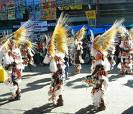


The Giant Lantern Festival is an annual festival held in December (Saturday before Christmas Eve) in the City of San Fernando in the Philippines. The festival features a competition of giant lanterns. Because of the popularity of the festival, the city has been nicknamed the "Christmas Capital of the Philippines".
The first lantern festival was held to honor President Manuel L. Quezon. At that time, Quezon made Arayat his rest area and converted Mount Arayat into a tourist resort. As a show of gratitude to Quezon, the people of San Fernando held a Christmas lantern contest to honor the first family. Quezon himself donated the prize for his lantern contest, which was personally awarded to the winner by First Lady Aurora Aragon Quezon.
In the years that followed, more innovations were introduced to the giant lanterns. Colored plastics replaced traditional papel de hapon. Large steel barrels called rotors also substituted the hand-controlled switches to manipulate the lights. And lanterns have grown in size, approximately 20-feet today, and illuminated by about 3,500 to 5,000 light bulbs.
History
The San Fernando lantern industry evolved from the Giant Lantern Festival of San Fernando. The festival, which is held every December, finds its roots in Bacolor where a much simpler activity was held. Following the transfer of the provincial capital from Bacolor to San Fernando in August 1904, this parul event followed as well. "Ligligan Parul" was said to have started in San Fernando in the year 1904. But some say that the "Ligligan Parul" did not happen immediately after the transfer and in fact began in 1908.
This predecessor of the modern day Giant Lantern Festival was actually a religious activity which we know today as “lubenas.” The lanterns measured just two feet in diameter, a far cry from the fifteen feet that we see today. These were created in each barrio from bamboo and other locally available materials. During the nine-day novena before Christmas, which coincided with the simbang gabi from December 16 to 24, these paruls were brought around each barrio in procession to their visita. Before the midnight Mass on Christmas Eve, the lanterns were brought to the town church together with the barrio patrons.
This tradition gradually evolved as the lanterns became bigger and the designs more intricate. Later, one big lantern was made for each barrio, which was created through a cooperative effort. Each resident contributed to its construction, from the concept and design, to the materials and labor. In the end, these lanterns became a symbol of unity for the barrios.
It was in the year 1931 that electricity was introduced to the San Fernando lantern, thus sparking the birth of the first Giant Lantern Festival. The added illusion of dancing lights highlighted the bright colors and intricate designs of these Giant Lanterns. At this time, the lights were controlled by individual switches that were turned on and off following the beat of the music. The barangays of Del Pilar, Sta. Lucia and San Jose were among the first barangays to participate in the festival.
The first lantern festival was held to honor President Manuel L. Quezon. At that time, Quezon made Arayat his rest area and converted Mount Arayat into a tourist resort. As a show of gratitude to Quezon, the people of San Fernando held a Christmas lantern contest to honor the first family. Quezon himself donated the prize for his lantern contest, which was personally awarded to the winner by First Lady Aurora Aragon Quezon.
In the years that followed, more innovations were introduced to the giant lanterns. Colored plastics replaced traditional papel de hapon. Large steel barrels called rotors also substituted the hand-controlled switches to manipulate the lights. And lanterns have grown in size, approximately 20-feet today, and illuminated by about 3,500 to 5,000 light bulbs.
History
The San Fernando lantern industry evolved from the Giant Lantern Festival of San Fernando. The festival, which is held every December, finds its roots in Bacolor where a much simpler activity was held. Following the transfer of the provincial capital from Bacolor to San Fernando in August 1904, this parul event followed as well. "Ligligan Parul" was said to have started in San Fernando in the year 1904. But some say that the "Ligligan Parul" did not happen immediately after the transfer and in fact began in 1908.
This predecessor of the modern day Giant Lantern Festival was actually a religious activity which we know today as “lubenas.” The lanterns measured just two feet in diameter, a far cry from the fifteen feet that we see today. These were created in each barrio from bamboo and other locally available materials. During the nine-day novena before Christmas, which coincided with the simbang gabi from December 16 to 24, these paruls were brought around each barrio in procession to their visita. Before the midnight Mass on Christmas Eve, the lanterns were brought to the town church together with the barrio patrons.
This tradition gradually evolved as the lanterns became bigger and the designs more intricate. Later, one big lantern was made for each barrio, which was created through a cooperative effort. Each resident contributed to its construction, from the concept and design, to the materials and labor. In the end, these lanterns became a symbol of unity for the barrios.
It was in the year 1931 that electricity was introduced to the San Fernando lantern, thus sparking the birth of the first Giant Lantern Festival. The added illusion of dancing lights highlighted the bright colors and intricate designs of these Giant Lanterns. At this time, the lights were controlled by individual switches that were turned on and off following the beat of the music. The barangays of Del Pilar, Sta. Lucia and San Jose were among the first barangays to participate in the festival.





































